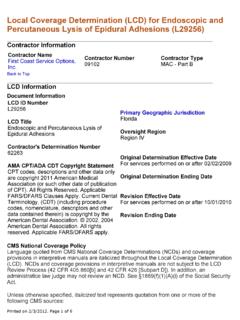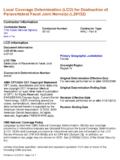Transcription of Conservative management of a lumbar …
1 0008-3194/2012/29 39/$ JCCA 2012J Can Chiropr Assoc 2012; 56(1) 29 Conservative management of a lumbar compression fracture in an osteoporotic patient: a case reportJohn A. Papa, DC, FCCPOR(C)** Private Practice, 338 Waterloo Street Unit 9, New Hamburg, Ontario, N3A 1T6. E-mail: JCCA 2012 But : Effectuer le suivi du traitement conservateur d un patient ost oporotique souffrant de lombalgie aigu en raison d une fracture lombaire avec tassement. Caract ristiques cliniques : Un homme de 74 ans souffre de lombalgies aigu s dans la r gion thoracolombaire survenues apr s avoir soulev un objet. Une valuation radiographique r v le une d min ralisation g n ralis e ainsi qu une fracture de L1 avec tassement cun iforme mod r . Intervention et r sultat : L approche th rapeutique conservatrice comprenait l ducation posturale, la modification d activit s, l lectroth rapie courants interf rentiels, l application de bandages lastiques (taping) en extension, la technique GrastonMD, et la prescription d exercices de r adaptation.
2 Les r sultats ont notamment t mesur s par une chelle verbale de notation de la douleur, la quantit de m dicaments ing r s, et le retour aux activit s de la vie quotidienne (AVQs). Le patient est parvenu une r solution long terme des sympt mes, sans r currence de la douleur en date du suivi effectu apr s 12 mois. R sum : Une combinaison de strat gies de r adaptation conservatrices peut tre mise en uvre avec succ s dans le traitement de patients ost oporotiques atteints de fractures vert brales ost oporotiques avec tassement d intensit l g re mod r e au niveau de la colonne lombaire.(JCCA 2012; 56(1):29 39)mots cl s : Fracture avec tassement, ost oporose, technique GrastonMD, chiropractie, r adaptationObjective: To chronicle the Conservative treatment and management of an osteoporotic patient presenting with acute back pain resulting from a lumbar compression fracture. Clinical features: A 74-year old male presented with acute back pain in the thoracolumbar region after an episode of lifting.
3 Radiographic evaluation revealed generalized demineralization and a moderate wedge compression fracture at L1. Intervention and outcome: The Conservative treatment approach included postural education, activity modification, interferential current, taping into extension, Graston Technique , and rehabilitative exercise prescription. Outcome measures included verbal pain rating scale, medication use, and a return to activities of daily living (ADLs). The patient attained long-term symptom resolution with no recurrence of pain at 12 month follow-up. Summary: A combination of Conservative rehabilitation strategies may be successfully implemented to treat osteoporotic patients with mild to moderate osteoporotic vertebral compression fracture of the lumbar spine.(JCCA 2012; 56(1):29 39)key words:compression fracture, osteoporosis, Graston Technique , chiropractic, rehabilitation30 J Can Chiropr Assoc 2012; 56(1) Conservative management of a lumbar compression fracture in an osteoporotic patient: a case reportIntroductionIndividuals with osteoporosis have a greater likelihood of suffering vertebral compression fractures (VCFs), which can range from mild to severe in terms of associated pain and resultant In the United States, it is esti-mated that at least 10 million people suffer from osteopor-osis and an additional 18 million people are at significant risk for development of the disorder.
4 Within this affected group, it is estimated that 700,000 VCFs occur each year and approximately 70,000 result in hospitalization, with an average hospital stay per patient of 8 The risk of major osteoporotic fracture in Canada is among the high-est in the world,3 with the incidence of VCFs expected to increase as the Canadian population The annual incidence of osteoporotic vertebral compression fractures (OVCFs) among Canadian women is currently reported to be approximately 37, Although considered a female health issue, osteoporosis is also becoming a major health concern among 8It is estimated that many OVCFs remain asymptom-atic, and that only one-third of individuals seek immedi-ate medical attention, presenting predominantly as acute back pain 12 For any given case, the diagnosis of a single OVCF increases the risk of subsequent frac-tures by a factor of Patient population studies indi-cate an increased mortality rate in patients with OVCFs that correlates with the number of involved In addition to acute pain and the risk for developing chronic pain, OVCFs may also be accompanied by other physical and emotional ,9 11 Early recog-nition, diagnosis.
5 And Conservative management can play important roles in minimizing the negative sequelae of case study was conducted to evaluate the con-servative treatment and management of an osteoporotic patient presenting with acute back pain resulting from a lumbar compression fracture. Salient clinical features and diagnostic considerations are also reportA 74-year old male presented with acute back pain of three days duration localized to the region of the thoracol-umbar spine. The patient explained that this pain occurred while he was lifting 30 40 lb pieces of wood. During the mid-point of a lift, with his spine forward flexed, he re-portedly heard a pop in his back and a sensation of pain immediately ensued. The patient did not seek med-ical treatment following this incident. He reports that he managed his symptoms with over the counter medication (ibuprofen).The patient rated his pain as 8/10 on the Verbal Pain Rating Scale (VPRS) where 0 is no pain and 10 is the worst pain that he had ever experienced.
6 The pain was described as sharp and stabbing, and it was exacerbated by direct pressure over the painful area and any move-ments of the lower axial spine. He denied any radiating/referred pain symptoms into the lower extremities or dif-ficulty with bowel and bladder function. Past medical history revealed that he had been diagnosed with mild osteoporosis two years prior. Systems review and family health history was unremarkable. The patient was a life-long non-smoker. He did not report any previous history of disabling back injury. He indicated that he lived a very active lifestyle and walked two to four kilometres daily. His current state did not allow for him to continue his daily walking routine and he was having trouble getting a good night s sleep due to difficulty with finding a com-fortable observation revealed that the patient walked slowly and moved in a guarded fashion during trans-fers. A slightly forward stooped posture was noted in the standing position.
7 lumbar ranges of motion were signifi-cantly restricted in all planes due to pain. Motor, reflex, and sensory testing for the lower extremities was within normal limits bilaterally. Seated straight leg raising was unremarkable bilaterally for nerve root tension signs. Percussion of the spinous processes with a reflex ham-mer revealed tenderness most notably over T11, T12, L1 and L2. Digital posterior to anterior (P-A) pressure of the spinous processes reproduced a sharp pain at these levels. Palpation revealed marked muscle spasm bilaterally in the thoracolumbar paraspinal consideration of the patient s reported health history, mechanism of injury, and physical examination findings, A-P and lateral thoracic and lumbar radiographs were completed due to suspected OVCF. The radiographic examination revealed generalized demineralization and a moderate wedge compression fracture at L1. There were no other radiographic features of significance identified that would clearly explain the patient s acute symptom office treatment commenced four days after initial J Can Chiropr Assoc 2012; 56(1) 31JA Papapresentation.
8 The patient was instructed after the initial assessment to maintain a neutral spine position and try to avoid forward stooped/spinal flexion movements. He was also advised to try and stay mobile and avoid pro-longed inactivity. Initial treatment was focused on provid-ing adequate pain control. This was accomplished with interferential current (IFC) applied to the hypertonic thoracolumbar paraspinal muscles, followed by taping of the thoracolumbar spine into a position of slight extension bias (Figures 1A C). Exercises consisting of abdominal bracing, scapular setting, and gentle extension movements of the thoracolumbar region were introduced in week patient made continuous improvement during the course of treatment with respect to pain scores, as well as his functional and impairment status. At the beginning of week 5, IFC application and taping into extension was discontinued. Augmented soft tissue mobilization using Graston Technique (GT) was introduced and applied to the thoracolumbar paraspinal muscles.
9 The patient s exer-cise program was also increased at this time. A sampling of these exercises is provided in Figures 2 7. A summary of the full treatment protocol and prescribed exercises is included in Table week 9, the patient reported no spinal stiffness or pain and had resumed all his ADLs. The patient was en-couraged to continue with his exercise program as a pre-ventative measure. He was subsequently discharged from active care and advised to return if his symptoms recurred. At 12 month follow-up conducted via telephone, the pa-tient reported no recurrence of fractures are one of the important clinical mani-festations of osteoporosis. The prevalence of vertebral fractures rises with age, and may increase as much as five times between the ages of 50 54 and 75 The risk fac-tors associated with VCFs and osteoporosis are similar1, and include nonmodifiable and modifiable factors (Table 2). Early recognition, diagnosis, and Conservative man-agement can play an important role in minimizing the complications and negative sequelae of OVCF (Table 3).
10 Unfortunately only about one third of VCFs are actual-ly 16 Pain symptoms arising from OVCFs can be variable, ranging from asymptomatic,17 to acute and intolerable Fractures may also escape diagno-sis due to being dismissed as muscle strains, arthritis, or Figure 1(A C) Taping into extension bias of the thoracolumbar spineABC32 J Can Chiropr Assoc 2012; 56(1) Conservative management of a lumbar compression fracture in an osteoporotic patient: a case reportFigure 2 Proprioceptive training with one-legged stanceFigure 3 Lumbopelvic conditioning with bridging exerciseFigure 4 Theraband scapular retraction exercisesFigure 5 Proprioceptive training with a Rocker BoardJ Can Chiropr Assoc 2012; 56(1) 33JA Papaa normal part of aging,1,10 and may have no clear event tied to the onset of symptoms. Individuals with advanced osteoporosis may sustain a VCF after sneezing or lifting a light object, whereas patients with mild to moderate osteoporosis will require a greater force to create a frac-ture such as falling off a chair, tripping, or attempting to lift a heavy Health professionals should consider OVCF as a diagnostic differential in all patients older than 50 with acute onset of back pain if one or more risk fac-tors are is reported that many patients with OVCFs experi-ence a relatively benign natural history with predictable pain improvement over 6 to 12 ,12 However, these sources also acknowledge that some patients experience persistent pain and disability.








